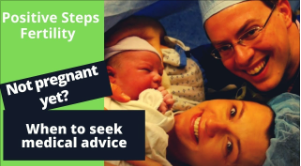Does the female orgasm play a role in conception? This is a question many women and couples have asked me in my years as a fertility specialist. It’s a topic shrouded in both mystery and misinformation, blending the lines between scientific fact and age-old myths. Understanding the connection between orgasm and conception can further enhance our knowledge of how orgasm and conception interplay, potentially impacting fertility outcomes.
Understanding conception, a process deeply rooted in biology and physiology, requires us to not only explore these questions but also to demystify the nuances surrounding them. In this blog, we delve into the world of female orgasm and its potential link to conception, unraveling the science behind this natural phenomenon and the implications of orgasm and conception on fertility. The relationship between orgasm and conception is a fascinating topic that warrants deeper exploration.
Do You Have Fertility Questions?
Discover answers in just one visit with the Parryscope Fertility Diagnostic Test, developed by Dr. John Preston Parry. This patented, gentle, 20-minute test evaluates the three core factors of female fertility without the discomfort of traditional procedures.
- Ovarian Egg Reserve – How many quality eggs do you have?
- Fallopian Tube Patency – Are your tubes open so egg and sperm can meet?
- Uterine Readiness – Is your uterus prepared to support a pregnancy?
You’ll get immediate, personalized results in plain language—plus expert guidance on your best next steps regarding the relationship between orgasm and conception.
★★★★★ “We did our Parryscope in January of 2024, and one year later, we found out our little miracle stuck!.”
— Hannah LeBlanc
Understanding the Female Orgasm
To demystify the role of female orgasm in conception, we first need to understand what it is. The female orgasm is a complex, multifaceted experience, encompassing both physiological and psychological elements. Physiologically, it is characterized by rhythmic contractions of the pelvic muscles, along with increased heart rate, blood pressure, and often a heightened sense of pleasure. These contractions are thought to aid in the movement of sperm through the cervix, potentially influencing conception.
From a psychological standpoint, the orgasm is a deeply personal and varied experience. It can range from intensely pleasurable to subtle, and for some, it may be elusive. This variability is completely normal, reflecting the diverse nature of female sexual experience.
Despite its commonality, there are numerous misconceptions about female orgasm. One of the most prevalent is the notion that orgasm is necessary for conception. This is a myth. While the experience can enhance the intimate and emotional aspects of a sexual relationship, it is not a prerequisite for conception. Many women conceive without experiencing orgasm during the act of intercourse.
Ultimately, the journey towards conception is multifaceted, with the interplay of orgasm and conception adding valuable insight into the fertility landscape.
It’s essential for couples to recognize that while orgasm is not strictly necessary for conception, it can play a supportive role in the overall fertility process.
In summary, acknowledging the connection between orgasm and conception not only enriches our understanding of fertility but also emphasizes the importance of sexual satisfaction in the reproductive journey.
As we integrate our knowledge of orgasm and conception, we can better navigate the complexities of fertility and intimate relationships.
Understanding the role of orgasm in conception can empower couples to create a supportive and enriching environment for trying to conceive.
The exploration of orgasm and conception not only sheds light on the physiological aspects but also encourages couples to engage in open discussions about their sexual health.
Ultimately, understanding the biological factors associated with both orgasm and conception can lead to more informed decisions regarding fertility treatments.
As we delve deeper into the biological aspects of conception, the interplay of orgasm and conception serves as a reminder of the complexity of the human reproductive system.
Research continues to explore how the dynamics of orgasm and conception influence overall reproductive success.
Furthermore, recognizing the links between orgasm and conception can enhance our knowledge of reproductive health.
When we examine the biological perspective of conception, the role of female orgasm becomes a critical component in understanding the fertility process.
Moreover, the emotional connections fostered during sexual activity, including the experience of orgasm, may also play a significant role in the journey toward conception.
Interestingly, studies have shown that the female orgasm can create an optimal environment for sperm to reach the egg, suggesting that the dynamics of orgasm and conception are more intertwined than previously thought.
Exploring the connection between orgasm and conception reveals that many women may benefit from understanding how their own sexual experiences can influence their fertility journey.
Another common misconception is the belief that all women experience orgasm in the same way. In reality, the experience is highly individualistic, influenced by a myriad of factors including physical health, emotional state, and the nature of the sexual activity.
Understanding these aspects of female orgasm is crucial in comprehending its potential role in fertility and conception. The journey through the realms of conception and fertility is complex, and female orgasm is just one of the many facets that contribute to our understanding of the fertility process.
The Biological Perspective of The Female Orgasm and Conception
Understanding conception from a biological standpoint is essential in unraveling the mysteries of fertility. Conception is the process that begins with the fertilization of an egg (ovum) by a sperm, leading to the formation of an embryo. This intricate process starts with ovulation, the release of a mature egg from the ovary. Once released, the egg travels down the fallopian tube, where it may meet sperm for potential fertilization.
Several factors influence the likelihood of conception. Key among them is sperm quality , which encompasses sperm count, mobility, etc. High-quality sperm increases the chances of successful fertilization. Equally important is the timing of intercourse relative to ovulation. Fertilization is most likely when intercourse occurs close to the time of ovulation, as the egg remains viable for a limited period post-ovulation.
The female reproductive system plays a critical role in this process. It includes the ovaries, which produce eggs; the fallopian tubes, where fertilization occurs; the uterus, where the fertilized egg implants and grows; and the cervix and vagina, which form the passage for sperm entry. The hormonal interplay governing this system is intricate, with estrogen and progesterone playing vital roles in regulating ovulation and preparing the uterus for potential pregnancy.
Historical Views on Female Orgasm and Fertility
Historically, the perceived role of female orgasm in fertility has undergone significant shifts. In ancient times, certain cultures believed that female orgasm was necessary for conception. This belief stemmed from the notion that orgasm in both partners was essential for the ‘mingling’ of male and female ‘essences’ or fluids, considered crucial for procreation.
As medical science progressed, especially in the 18th and 19th centuries, these views began to change. The advent of more scientific understandings of human anatomy and reproduction led to the dismissal of some earlier beliefs. By the late 19th and early 20th centuries, the role of female orgasm in conception was largely downplayed in medical literature, with the focus shifting more towards the physiological aspects of sperm transport and egg fertilization.
The 20th century brought further shifts in perspective, influenced by psychoanalytic theories and a deeper understanding of human sexuality. While modern science recognizes the non-essential role of female orgasm in the mechanical process of conception, there is growing acknowledgment of its potential indirect benefits. These include the possible facilitation of sperm transport and the enhancement of the overall sexual experience, which could positively affect fertility indirectly by promoting regular sexual activity.
As we continue to explore the interplay of sexuality and fertility, it’s important to acknowledge how our understanding has evolved and continues to evolve, shaped by both scientific discoveries and societal attitudes towards sexuality and reproduction.
Current Scientific Findings
Recent studies have painted a complex picture regarding the role of female orgasm in conception. While some research suggests that contractions associated with orgasm may help ‘suck’ sperm up the cervix and into the uterus, increasing the chances of fertilization, other studies find no significant correlation between orgasm and increased fertility.
The challenge in these studies often lies in the variability of sexual experiences and the difficulty in isolating variables in human reproductive behavior.
A study conducted in the 1950s by American sex-education pioneers William Masters and Virginia Johnson used dyed artificial semen and X-ray technology to investigate the “upsuck theory.” This theory hypothesized that uterine contractions during an orgasm help propel semen into the vaginal canal, thus aiding conception.
Their experiment debunked this theory, showing no evidence of increased semen retention during orgasm. This research, along with other studies, suggests that while orgasms might not directly impact conception, factors like the release of oxytocin during orgasm, which can decrease stress and increase feelings of intimacy, might have indirect benefits for conception.
The evidence remains inconclusive. Some researchers argue that while orgasm may not directly influence conception, it could play a role in sperm retention, potentially increasing the likelihood of conception. However, it’s important to note that many women conceive without experiencing orgasm during intercourse, indicating that it is not a requirement for successful fertilization.
The Role of Female Orgasm in Fertility Treatments
In the realm of fertility treatments, the role of female orgasm is viewed more as a component of overall sexual health rather than a direct factor in treatment efficacy. Fertility specialists acknowledge that while orgasm may not significantly impact the success rates of treatments like IVF (In Vitro Fertilization) or IUI (Intrauterine Insemination), the sexual satisfaction and emotional well-being it brings can be beneficial.
A positive sexual experience, including orgasm, can reduce stress and enhance intimacy between partners during fertility treatments. Thus, while the physiological impact of orgasm on these treatments may be limited, its role in maintaining a healthy relationship and emotional state cannot be overlooked.
Psychological and Emotional Considerations
Focusing heavily on the attainment of orgasm for conception can lead to added stress and pressure, which can be counterproductive. It’s important for couples to understand that conception is a multifaceted process, influenced by a variety of factors, and reducing it to a single element like orgasm can lead to unnecessary frustration and anxiety.
Adopting a holistic approach to fertility is crucial. This involves understanding the interplay of physical, emotional, and psychological health. Couples are encouraged to focus on overall well-being, intimacy, and mutual support, rather than fixating on specific aspects of sexual activity. Obviously, having a fertility specialist guiding you through the complexity of conception and treatments is essential as well.
There is no direct relationship between the female orgasm and conception
While the female orgasm remains an area of interest in the context of conception, current scientific evidence does not support a direct, essential role in increasing conception likelihood. It is one of many components of the complex dance of human reproduction.
The consensus in the medical community is to view the female orgasm as a part of the broader sexual and emotional experience of couples rather than a clinical tool for enhancing fertility. For couples trying to conceive, the recommendation is to maintain a balanced perspective, focusing on overall health, emotional connection, and enjoying the journey towards parenthood, rather than fixating on specific aspects of their sexual encounters.
If you are struggling with infertility, reach out to a specialist today. A fertility specialist can walk you through the many factors that compose your reproductive health and get you down the right path in your fertility journey. Don’t suffer in silence. Find answers. Find peace.
Do you still have questions? We are here to help. Contact us at Positive Steps to speak to our fertility specialists to tailor a path that suits your unique situation.
Other information you may find of interest.




